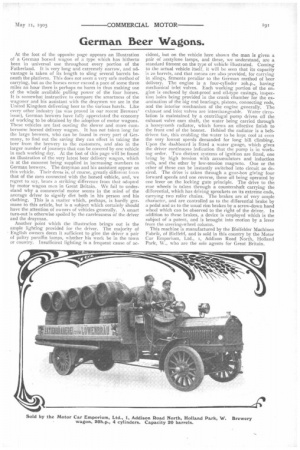German Beer Wagons.
Page 19

If you've noticed an error in this article please click here to report it so we can fix it.
At the foot of the opposite page appears an illustration of a German horsed wagon of a type which has hitherto been in universal use throughout every portion of the Fatherland. It is very long and extremely narrow, and advantage is taken of its length to sling several barrels beneath the platform. This does not seem a very safe method of carrying, but as the horses never exceed a pace of some three miles an hour there is perhaps no harm in thus making use of the whole available pulling power of the four horses. It is somewhat instructive to compare the smartness of the wagoner and his assistant with the draymen we see in the United Kingdom delivering beer to the various hotels. Like every other industry (as was proved in our recent Brewers' issue), German brewers have fully appreciated the economy of working to be obtained by the adoption of motor wagons. These vehicles are fast ousting the slower and more cumbersome horsed delivery wagon. It has not taken long for the large brewers, who can be found in every part of Germany, to find out the saving they can effect in taking the beer from the brewery to the customers, and also in the larger number of journeys that can be covered by one vehicle in each working day. At the foot of this page will be found an illustration of the very latest beer delivery wagon, which is at the moment being supplied in increasing numbers to German brewers. The drayman and his assistant appear on this vehicle. Their dress is, of course, greatly different from that of the men connected with the horsed vehicle, and, we regret to say, bears a striking difference from that adopted by motor wagon men in Great Britain. We fail to understand why a commercial motor seems in the mind of the average driver to signify dirt both in his person and his clothing. This is a matter which, perhaps, is hardly germane to this article, but is a subject which certainly should have the attention of owners of vehicles generally. A smart turn-out is otherwise spoiled by the carelessness of the driver and the drayman.
Another point which the illustration brings out is the ample lighting provided for the driver. The majority of English owners deem it sufficient to give the driver a pair of paltry paraffin lamps, whether his work be in the town or country. Insufficient lighting is a frequent cause of ac cident, but on the vehicle here shown the man is given a pair of acetylene lamps, and these, we understand, are a standard fitment on the type of vehicle illustrated. Coming to the actual vehicle itself, it will be seen that its capacity is 20 barrels, and that means are also provided, for carrying in slings, fitments peculiar to the German method of beer delivery. The engine is a four-cylinder 2oh.p., having mechanical inlet valves. Each working portion of the engine is enclosed by dust-proof and oil-type casings, inspection holes being provided in the crank chamber for the examination of the big end bearings, pistons, connecting rods, and the interior mechanism of the engine generally. The exhaust and inlet valves are interchangeable. \\later circulation is maintained by a centrifugal pump driven off the exhaust valve cam shaft, the water being carried through a honeycomb radiator, which forms an effective finish to the front end of the bonnet. Behind the radiator is a beltdriven fan, this enabling the water to he kept cool at even the very lowest speeds demanded for long hill climbing. L7pon the dashboard is fitted a water gauge, which gives the driver continuous indication that the pump is in working order. Two distinct systems of ignition are fitted, one being by high tension with accumulators and induction coils, and the other by low-tension magneto. One or the other of these can be instantly switched into circuit as desired. The drive is taken through a gear-box giving four forward speeds and one reverse, these all being operated by one lever on the locking gate principle. The drive to the rear wheels is taken through a countershaft carrying the differential, which has driving sprockets on its extreme ends, carrying two roller chains. The brakes are of very ample character, and are controlled as to the differential brake by a pedal and as to the usual rim brakes by a screw-down hand wheel which can be observed to the right of the driver. In addition to these brakes, a device is employed which is the subject of a patent, and is brought into motion by a lever from the steering-wheel column.
This machine is manufactured by the Bielfelder Machinen Fabrik, of Bielfeld, and is sold in this country by the Motor Car Emporium, Ltd., t, Addison Road North, Holland Park, W., who are the sole agents for Great Britain.
























